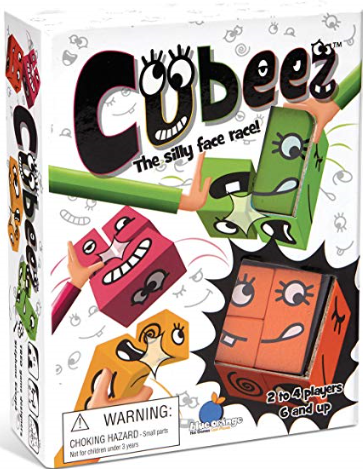 |
| A board-based memory game. |
This game is based on a children's book that I have neither read nor seen, but you can still play the game without it. I don't think I've ever seen a memory game with a game board, and that means that one of each of your sets is already found. The game board shows four large bears and under each bear are pictures of eight animals. The 32 animal cards will match the animals on the board (minus the bears). Some of the animals are fox, duck, frog, horse, monkey, fish and penguin. The pieces are sturdy and the game board is folded into fourths in the box.
Object:
Be the first to cover all of your eight animals and recite the rhyme.
Set up:
Place the board in the middle of the players. Turn the four bear cards face-down and each player chooses one. The cards will show either a panda bear or a brown bear. The picture you choose will tell you where to sit at the board. Take your place at the board. Turn the 32 animal cards face-down in the middle of the board or off to the side.
Play:
Players take turns flipping one animal card face-up. If it matches one of the eight animals that they need, they pick it up and place it on the picture in front of them. If not, they turn it back over in the same spot and the next person plays. Once someone matches all eight pictures in front of them they recite the rhyme: Brown bear, brown bear (or panda bear, panda bear) what do you see? I see a... The player will then name the eight animals lined up in front of them and win the game.
Try this:
- Skip the board and just play a memory game as there are 16 sets in all. There are two of each animal card since one panda and one brown bear have the same set of pictures and the other panda and brown bear have a different set of pictures.
- Name each animal, including the color, each time you turn over an animal.
- Place only the cards needed on the board during set up. For instance, if only two people are playing, only 16 cards will be needed.
- Place one of each animal in a pair upside-down when you are playing a memory game without the board. The players will have to recognize a set when the cards are in different orientations. The side of the card that does not picture the animal has stripes (see the image above). The red strip is the bottom of each card. Savvy players may figure out that if they turn over a card with a red strip at the bottom, the match to that will have a red strip at the top. It may take a few games to put it together though.
- Give the player a small stack of cards and ask them to place them on the board during set up, pushing each top card off the stack with the thumb as he separates them.
- Require that each card is picked up where it lies and not moved to the edge for a better grip. The cards are about 1/16 inch thick, so they are not flat.
- Make the game a little more difficult by requiring players to find their sets in the same sequence as the animals that are pictured lined up on the board. If you match one of your sets out of sequence, you have to leave it in place until you come to that animal in your line-up.
- Work
on visual discrimination, manual dexterity, in-hand manipulation,
eye-hand coordination, visual memory, socialization skills, process
skills, play and leisure exploration and participation
In the box: game board, 4 bear cards, 32 animal cards
If you are interested in purchasing this game or just want more information, click on the image below.




